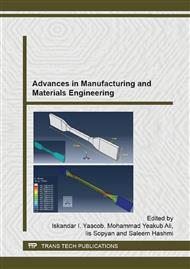p.96
p.100
p.104
p.109
p.113
p.117
p.122
p.126
p.133
Multi Objective Optimisation for High Speed End Milling Using Simulated Annealing Algorithm
Abstract:
Machining at high cutting speeds produces higher temperatures in the cutting zone. These temperatures affect the surface quality and flank wear progress. Therefore, determining the optimum cutting levels to achieve the minimum surface roughness and flank wear is an important for it is economical and mechanical issues. This paper presents the optimization of machining parameters in end milling processes by using the simulated annealing algorithm (SAA) as one of the unconventional methods in optimization. The minimum arithmetic mean roughness (Ra) and minimum flank wear length were the objectives. The mathematical models have been developed, in terms of cutting speed, feed rate, and axial depth of cut by using Response surface Methodology (RSM). This paper presents the optimum cutting parameters: cutting speed, feed rate and depth of cut to achieve the minimum values of surface roughness and minimum flank wear length. The results show that the cutting speed in the range of 200 m/min, feed rate of 0.05 mm/tooth and depth of cut of 0.1mm gave the minimum arithmetic mean roughness (Ra) for 164 and minimum flank wear for 0.0379 in the boundary design of the experiment after 8000 iteration.
Info:
Periodical:
Pages:
113-116
Citation:
Online since:
July 2015
Price:
Сopyright:
© 2015 Trans Tech Publications Ltd. All Rights Reserved
Share:
Citation:


